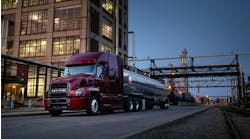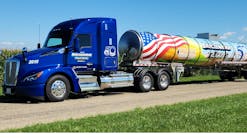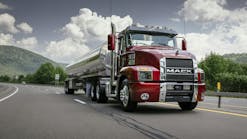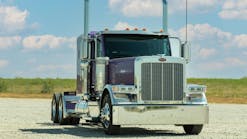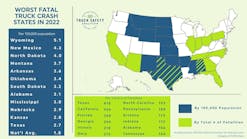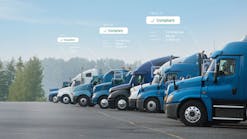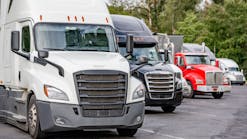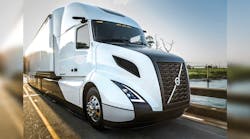VOLVO Trucks officials recently provided an update on the company’s participation in the Department of Energy’s (DOE’s) SuperTruck II program. They discussed the program during the American Trucking Associations’ 2016 Management Conference & Exhibition in Las Vegas NV.
Working with $20 million in federal funding from DOE’s SuperTruck II program, Volvo Trucks will develop an advanced heavy-duty tractor-trailer concept delivering increased freight-hauling efficiency and corresponding reductions in carbon emissions. The Volvo Group and its partners will match the development funds dollar-for-dollar.
SuperTruck II is supported by DOE under the American Recovery and Reinvestment Act of 2009. The original SuperTruck program began in 2010, and involved truck builders and other partners, including national labs, universities, and component suppliers.
In SuperTruck II, Volvo Trucks will use alternative engine designs and an integrated system approach to build a lightweight tractor-trailer that exceeds the freight efficiency goal of 100% improvement on a ton-mile-per-gallon basis compared with a 2009 baseline. The team also will demonstrate a powertrain capable of 55% brake thermal efficiency.
Volvo will leverage its industry-leading expertise in vehicle development, along with established partnerships with advanced technology and trailer equipment vendors. It will also draw from the company’s legacy of innovation in the areas of energy efficiency, safety and environmental solutions. The majority of the work will be performed in Greensboro, North Carolina, which is the North American headquarters for Volvo Trucks, and at the Volvo powertrain facility in Hagerstown, Maryland.
First SuperTruck
Volvo recently unveiled its first SuperTruck demonstrator at an event at the DOE in Washington DC. The initial Volvo SuperTruck achieved a freight efficiency improvement of 88%, exceeding the 50% improvement goal set by the program. The tractor-trailer combination boosted fuel efficiency by 70%—exceeding 12 miles per gallon, with some test runs showing more than 13 miles per gallon—in road tests.
“Our research under the first SuperTruck program has already paid dividends in our existing vehicle and engine product lines,” said Göran Nyberg, president of Volvo Trucks North America. “We look forward to additional breakthroughs that will deliver benefits to our customers and the environment.”
Volvo already introduced in its 2017 powertrain lineup some of the improvements from the first SuperTruck program, including new, enhanced Volvo D11 and D13 engines, featuring an improved “wave” piston bowl design, a common rail fuel injection system, turbo compounding for the D13 engine, and a one-box exhaust aftertreatment system (EATS). Aerodynamic enhancements for Volvo’s model year 2016 Volvo VNL sleeper tractors were also a result of the SuperTruck program.
Volvo’s partners include Michelin Americas Research Company (tires), Wabash National (trailer), Metalsa (lightweight frame), Johnson-Matthey Inc (exhaust aftertreatment system catalysts), Oak Ridge National Laboratory (exhaust aftertreatment system testing/analysis), Peloton Technology (connected vehicle / platooning), Pennsylvania State University (connected vehicle testing), Knight Transportation (long-haul fleet), and Wegmans Food Markets (regional-haul fleet).
Other builders
Other participants in SuperTruck II include Daimler Trucks North America (DTNA) and Peterbilt Motors Company.
Peterbilt announced it will work with Cummins to develop technologies under the DOE’s five-year SuperTruck II program. The technologies will double freight efficiency to achieve Greenhouse Gas Emissions (GHG) requirements set forth for model years 2021, 2024, and 2027.
“Peterbilt is proud to support the DOE’s SuperTruck II program in cooperation with Cummins,” said Darrin Siver, Peterbilt general manager and PACCAR vice-president. “We will work together to build on the success of our original SuperTruck program.”
Wayne Eckerle, Cummins vice-president of research and technology, said: “Cummins and the entire team are focused on developing technologies that can transform the industry and help our customers be more successful while continuing to be great stewards of the environment. Combining some of the best technical minds available for this project, I am confident that we can reach our goals and deliver results that are a win for our customers, a win for our organizations and a win for the environment.”
Peterbilt will work to improve aerodynamics by 15% in all wind directions, which will provide customers an up to 7.5% improvement in fuel economy. This enhancement will decrease aerodynamic drag and rolling resistance.
“Peterbilt recognizes customers’ needs for reduced fuel costs,” said Scott Newhouse, Peterbilt chief engineer. “Our aerodynamic and fuel saving initiatives align with the goals of the SuperTruck II program.”
Peterbilt will work to improve fuel economy and efficiency through technologies including auxiliary systems such as air compressors, power steering pumps, and cooling pumps. To reduce rolling resistance, Peterbilt will team with tire manufacturing partners to investigate alternative compounds and tire configurations for optimized surface contact. The team hopes to not only meet, but exceed the goal of the doubling the baseline truck’s efficiency.
On the original SuperTruck program, the Peterbilt and Cummins team demonstrated a 66% fuel economy improvement and 76% freight efficiency improvement over the baseline truck. Advanced aerodynamics, predictive cruise control, chassis light-weighting, and battery-based A/C systems for idle reduction led to these improvements. These options are now available on the Model 579 EPIQ.
Environmental improvements
DTNA officials announced that the company will receive a $20 million DOE grant to participate in the next phase of the SuperTruck program. The new award is part of a multimillion dollar, multi-year effort to increase the fuel economy of medium- and heavy-duty vehicles while decreasing carbon pollution.
DTNA and its project partners exceeded the initial program goals by designing a truck that demonstrated more than 115% improvement in overall freight efficiency over a 2009 baseline truck and achieved more than 50% engine brake thermal efficiency.
“We are proud of what we accomplished with the first SuperTruck program, but we knew that there was more opportunity to make gains in efficiency to improve both the environment and the profitability of our customers,” said Derek Rotz, principal investigator for SuperTruck, Daimler Trucks North America. “Together with our partners, we will explore new technologies and realistic opportunities to improve the environment.” ♦
